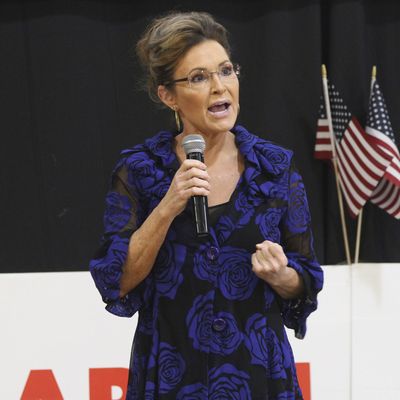
Following Tuesday’s primary in Alaska, headline writers have had the unenviable task of trying to simplify a complex reality. “Sarah Palin advances to November general election in Alaska House Race,” The Wall Street Journal announced. That’s true, so far as it goes. But the conjunction of a special election to replace Alaska’s lone, longtime U.S. House member with the unveiling of a new and unique election system has made it unclear whether Sarah Barracuda is actually headed to Washington.
At the moment, Palin has two shots at making it to Congress: one as the potential winner of a special election whose results are still up in the air and the other as the potential winner of a general election in November. Palin’s biggest asset and biggest liability are the same. It’s the celebrity status she obtained as a shock vice-presidential nominee in 2008, which she parlayed (after she abruptly resigned the governorship) into book sales, TV shows, and general notoriety, most of it with Alaska as merely a backdrop. No one can rival her name ID, and her identification with the state is indelible. But at the same time, she’s built up a lot of resentment among voters and Alaska Republican activists who are tired of her shtick and would prefer their sole House member be a workhorse rather than a showhorse. It’s this mixed baggage — along with a prize endorsement from Donald Trump — that Palin brought to her surprise political comeback this year.
Don Young, Alaska’s one representative in the House since 1973, died in March. A 48-candidate field, including Palin, formed for the special election to fill the remaining months of his current term. The June 11 special-election primary marked the debut of a new election system: The top four finishers in the nonpartisan primary would proceed to an August 16 general election. On the same day in August, the state would hold another top-four primary to determine the finalists for a full two-year term in the House. There was yet another wrinkle: For the first time, Alaska voters choosing among the top four for each office would have the opportunity to rank the candidates by preference. Under this “ranked-choice” system, candidates who finished at the bottom would be eliminated and votes would be redistributed until someone won a majority.
On June 11, Palin, fellow Republican Don Begich III, independent Al Gross, and Democrat Mary Peltola finished in the top four spots. Gross subsequently dropped out of the general election, making the top four a top three; that means the third-place finisher on August 16 would be eliminated before the winner was determined by the ranked-choice process. With 69 percent of the vote tabulated, Peltola consolidated the Democratic vote and was running first with 38 percent of the vote, Palin was second with 32 percent, and Begich was third with 29 percent.
Since Alaska counts mail ballots postmarked by Election Day and received by August 26, it will be a while before we know whether Palin or Begich will be eliminated. If Begich survives, he will likely beat Peltola after Palin voters’ second choices are tabulated, given the majority Alaska Republicans enjoy. But Palin is controversial enough that if she makes the cut, Peltola could win when it’s all added up. One of the three candidates will head to Washington in September to serve until early January when Young’s term ends.
What happens to the House seat then depends on the parallel regular election. In that contest, the top-four primary on August 16 showed Peltola, Palin, Begich, and a third Republican, Tara Sweeney, clearly nailing down general-election positions. What will happen in November is anyone’s guess, but we will know in the next week or so whether Palin is still in the running for the short stint in the House. No matter what happens in that contest, Palin will have another shot at a full term in November and a second chance to make a splashy return to the national political scene.
More on the Midterms
- Are Democrats the Party of Low-Turnout Elections Now?
- New Midterms Data Reveals Good News for Democrats in 2024
- The Return of the Emerging Democratic Majority?






























